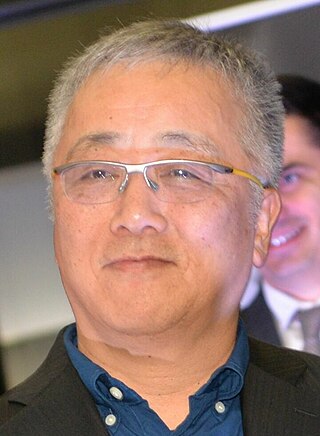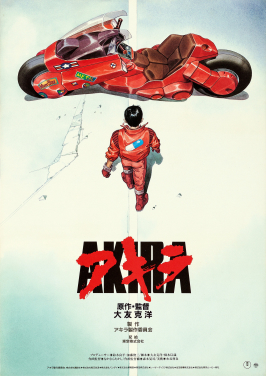
Katsuhiro Otomo is a Japanese manga artist, screenwriter, animator, and film director. He is best known as the creator of Akira, both the original 1982 manga series and the 1988 animated film adaptation. He was decorated a Chevalier of the French Ordre des Arts et des Lettres in 2005, promoted to Officier of the order in 2014, became the fourth manga artist ever inducted into the American Eisner Award Hall of Fame in 2012, and was awarded the Purple Medal of Honor from the Japanese government in 2013. Otomo later received the Winsor McCay Award at the 41st Annie Awards in 2014 and the 2015 Grand Prix de la ville d'Angoulême, the first manga artist to receive the award. Otomo is married to Yoko Otomo. Together they have one child, a son named Shohei Otomo, who is also an artist.
The history of anime can be traced back to the start of the 20th century, with the earliest verifiable films dating from 1917. Before the advent of film, Japan already had a rich tradition of entertainment with colourful painted figures moving across the projection screen in utsushi-e (写し絵), a particular Japanese type of magic lantern show popular in the 19th century. Possibly inspired by European phantasmagoria shows, utsushi-e showmen used mechanical slides and developed lightweight wooden projectors (furo) that were handheld so that several performers could each control the motions of different projected figures.

Memories is a 1995 Japanese animated science fiction anthology film with Katsuhiro Otomo as executive producer, and based on three of his manga short stories. The film is composed of three shorts: Magnetic Rose, directed by Studio 4°C co-founder Kōji Morimoto and written by Satoshi Kon; Stink Bomb, directed by Tensai Okamura and written by Otomo, and Cannon Fodder, written and directed by Otomo himself.

Akira is a 1988 Japanese animated cyberpunk action film directed by Katsuhiro Otomo, produced by Ryōhei Suzuki and Shunzō Katō, and written by Otomo and Izo Hashimoto, based on Otomo's 1982 manga of the same name. Set in a dystopian 2019, it tells the story of Shōtarō Kaneda, the leader of a biker gang whose childhood friend, Tetsuo Shima, acquires incredible telekinetic abilities after a motorcycle accident, eventually threatening an entire military complex amid chaos and rebellion in the sprawling futuristic metropolis of Neo-Tokyo.

Superflat is a postmodern art movement, founded by Japanese contemporary artist Takashi Murakami, which is influenced by manga and anime. However, superflat does not have an explicit definition because Takashi Murakami does not want to limit the movement, but rather leave room for it to grow and evolve over time.
Studio 4°C Co., Ltd. is a Japanese animation studio founded by Eiko Tanaka and Kōji Morimoto in 1986. The name comes from the temperature at which water is most dense.

Robot Carnival is a Japanese anthology original video animation (OVA) and anime film released in 1987.
Noiseman Sound Insect is a short anime film directed by Koji Morimoto, with production by Studio 4°C and music by Yoko Kanno featuring a young Crystal Kay Williams singing the ending theme.
Takashi Nakamura is a Japanese animator and anime director. He is also a founding member of the Japan Animation Creators Association (JAniCA) labor group.

"Passion" is a song recorded by Japanese-American singer-songwriter Hikaru Utada, taken as the fourth single from her studio album Ultra Blue (2006). It premiered on December 14, 2005, in two physical formats and for digital consumption, distributed by EMI Japan and EastWorld. "Passion", alongside its English counterpart "Sanctuary", were used as the national and international theme songs to the Square Enix video game Kingdom Hearts II (2005); the tracks serve as the successors to "Hikari" and its English counterpart, "Simple and Clean", which are found on Kingdom Hearts.

"You Make Me Want to Be a Man" is a song recorded by Japanese recording artist Utada for her fifth studio album and second English album, Exodus (2004). It was written and produced by Utada, with co-production by her father Teruzane Utada. The track was inspired by her relationship with her husband at the time, Kazuaki Kiriya. Its themes include sexism and understanding each other from a different perspective. "You Make Me Want to Be a Man" premiered on January 1, 2005 as the fourth and final single from the album. Self-described as an electronic and dance-pop song, it contains numerous elements including J-pop and techno.

Freedom Project is a Japanese promotional project by Nissin Cup Noodles for their 35th anniversary in 2006. As part of the project, the 7-part OVA series, titled Freedom, was commissioned with and designed by Katsuhiro Otomo serving as the character and mecha designer. The series is directed by Shuhei Morita, creator of the award-winning animation short Kakurenbo, and is authored by celebrated writer Dai Satō, Katsuhiko Chiba and Yuuichi Nomura. The series openly displays its sponsor's product placement in numerous scenes in which characters are shown consuming Nissin Cup Noodles.

Neo Tokyo, also titled Manie-Manie on its title card, is a 1987 Japanese adult animated science fiction anthology film produced by Project Team Argos and Madhouse. The film was conceived and produced by Madhouse founders Masao Maruyama and Rintaro, the latter of whom served as composition organizer alongside Katsuhiro Ōtomo on the project.

Michael Arias is an American-born filmmaker active primarily in Japan. Though Arias has worked variously as visual effects artist, animation software developer, and producer, he is best known for his directorial debut, the anime feature Tekkonkinkreet, which established him as the first non-Japanese director of a major anime film.

Eiko Tanaka is a Japanese anime entrepreneur, the co-founder and current chief executive officer of Studio 4°C and producer of the studio. She is also the CEO of a producing company called Beyond C.
Japanese cyberpunk refers to cyberpunk fiction produced in Japan. There are two distinct subgenres of Japanese cyberpunk: live-action Japanese cyberpunk films, and cyberpunk manga and anime works.
Hiroyuki Kitakubo is a Japanese director, animator, and screenwriter.

Short Peace is a multimedia project composed of four short anime films produced by Sunrise and Shochiku, and a video game developed by Crispy's! and Grasshopper Manufacture. The four films were released in Japanese theaters on July 20, 2013 and were screened in North America during April 2014. Sentai Filmworks have licensed the films for North America. The video game was released in January 2014 in Japan, April 2014 in Europe, and September 2014 in North America. The game’s physical releases in Japan and Europe includes the four animated shorts as a bonus.
Hibiki Yoshizaki is a Japanese video artist, animator, music video director, art director, and motion graphics designer. He is best known for his animated music videos "ME!ME!ME!" and "GIRL," which gained mainstream popularity both in Japan and internationally after being submitted to the Japan Animator Expo. He also works as VJ Cotobuki with Naoki Nagayasu.
Shinya Ohira is a Japanese animator, director and character designer. He is known for his animation style with constantly shifting linework, described as being both realistic and surreal. He is part of the animator circle Studio Break, along with animators like Atsushi Yano and Shinji Hashimoto. He has worked on several Studio Ghibli films, with Hayao Miyazaki even storyboarding certain scenes with Ohira in mind for the animation.











